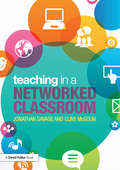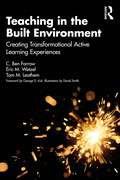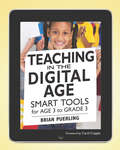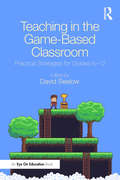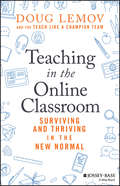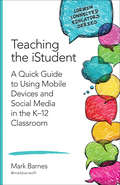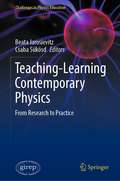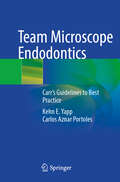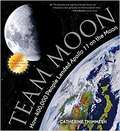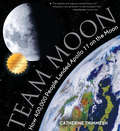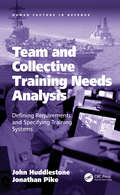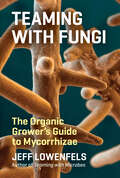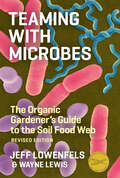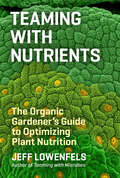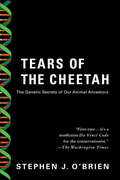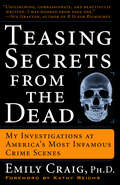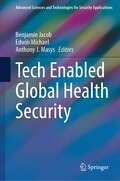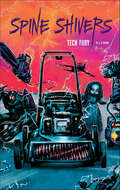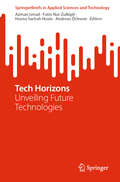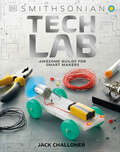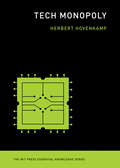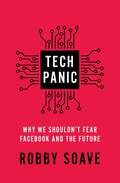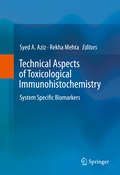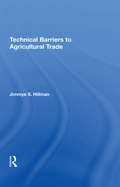- Table View
- List View
Teaching in a Networked Classroom
by Jonathan Savage Clive McGounThe pace of technological change has made the immediate and long-term future difficult, if not impossible, to predict. Teachers are forced to imagine the world they are preparing their students to live in. In this situation creativity becomes a vital resource for enabling uncertain futures to be embraced and an important attribute for students to have both for their learning and their employability in the future. In this book, the authors argue that creativity is a social and collaborative process that can be enhanced through online and digital technologies. Filled with case studies and practical tasks, it shows teachers how they can develop an approach to teaching and learning with digital technologies that is inherently social, collaborative and creative. Including case studies and practical examples of projects and lessons throughout, the chapters cover: Learning in a networked society An examination of sharing practices and how knowledge can be shared more effectively Potential pitfalls of virtual learning environments and public social networking sites Using digital media to plan schemes of work and lessons How to facilitate meaningful collaboration and discussion through digital media Creating online environments to enable students to share their understandings and learning Bringing together key ideas about creativity, collaborative learning and ICT in the classroom, this timely book will be an invaluable resource for all teachers.
Teaching in the Built Environment: Creating Transformational Active Learning Experiences
by C. Ben Farrow Eric Wetzel Thomas LeathemTeaching in the Built Environment: Creating Transformational Active Learning Experiences offers a blueprint for teaching success from an award-winning team of educators, with classroom-ready strategies for maximizing undergraduate learning in built environment disciplines. Drawing on the authors’ years of experience as education researchers and faculty at one of the nation’s top design and construction schools, this primer empowers instructors to implement high impact teaching practices in any educational setting, from intimate seminars to "mega classes" of hundreds of students. Chapters on internships, study abroad, and field experiences equip faculty with teaching tools guaranteed to work on or off campus. Just as importantly, this book identifies the teaching tactics that don’t work. The authors’ candid reflections on their own failed pedagogical experiments help instructors avoid confidence-shaking missteps and encourage them to turn teaching struggles into future successes. A thorough review of the latest education research provides theoretical context and empirical support for strategies direct from the authors’ award-winning classrooms, studios, and labs. Features: Classroom-tested strategies for maximizing undergraduates’ learning in built environment disciplines Adapted teaching methods from the authors’ award-winning classrooms, studios, and labs to any higher education setting An ideal resource for built environment faculty, from first timers to veteran educators The latest research on teaching and learning in design and construction disciplines A must-read for built environment educators, from first-time faculty to classroom veterans, Teaching in the Built Environment: Creating Transformational Active Learning Experiences inspires teaching that will resonate long past the semester’s end.
Teaching in the Digital Age
by Carol Copple Brian PuerlingTechnology is rapidly changing the ways we live our lives and interact with the world. It's also changing how you teach. Technology can enhance your classroom's complete curriculum and assessment and help you create and capture meaningful experiences, support inquiry, and expand your classroom's walls. This comprehensive framework will help you select and use a variety of technology and interactive media tools in your classroom-including digital cameras, audio recorders, webcams, publication and presentation tools, and multi-touch mobile devices.Reflecting Technology in Early Childhood Programs, the joint position statement of the National Association for the Education of Young Children and the Fred Rogers Center, Teaching in the Digital Age: Smart Tools for Age 3 to Grade 3 includesDevelopmentally appropriate and effective strategies to use technology to facilitate children's learning28 links to video clips that provide a deeper look at how these practices are used in real classrooms32 forms to help you plan, reflect on, and evaluate how you use technology to help children learnBrian Puerling, a National Board Certified Teacher and graduate of the Erikson Institute, is the Director of Education Technology at the Catherine Cook School in Chicago. He is a former preschool teacher, a member of the National Association for the Education of Young Children's Tech and Young Children Interest Forum, serves on the Sesame Workshop Teacher Council, is active with the Chicago Metro Association for the Education of Young Children, and is a popular presenter at national conferences.
Teaching in the Game-Based Classroom: Practical Strategies for Grades 6-12
by David SeelowTeaching in the Game-Based Classroom is a hands-on guide to leveraging students’ embrace of video games toward successful school performance. Evidence tells us that game-based learning can help teachers design classes, develop transformative learning tools, and assess progress on multiple levels not dependent on one-size-fits-all bubble sheets. Authored by game-savvy teachers in partnership with classroom-experienced academics, the highly varied chapters of this book are concise yet filled with sound pedagogical approaches. Middle and high school educators will find engaging new ways of inspiring students’ intrinsic motivation, skill refinement, positive culture-building, autonomy as learners, and more.
Teaching in the Online Classroom: Surviving and Thriving in the New Normal
by Doug LemovA timely guide to online teaching strategies from bestselling author Doug Lemov and the Teach Like a Champion team School closures in response to the covid-19 coronavirus pandemic resulted in an immediate and universal pivot to online teaching. More than 3.7 million teachers in the U.S. were suddenly asked to teach in an entirely new setting with little preparation and no advance notice. This has caused an unprecedented threat to children's education, giving rise to an urgent need for resources and guidance. The New Normal is a just-in-time response to educators’ call for help. Teaching expert Doug Lemov and his colleagues spent weeks studying videos of online teaching and they now provide educators in the midst of this transition with a clear guide to engaging and educating their students online. Although the transition to online education is happening more abruptly than anyone anticipated, technology-supported teaching may be here to stay. This guide explores the challenges involved in online teaching and guides educators and administrators to identify and understand best practices. It is a valuable tool to help you and your students succeed in synchronous and asynchronous settings this school year and beyond. Learn strategies for engaging students more fully online Find new techniques to assess student progress from afar Discover tools for building online classroom culture, combating online distractions, and more Watch videos of teachers building rigor and relationships during online instruction The New Normal features real-world examples you can apply and adapt right away in your own online classroom to allow you to survive and thrive online.
Teaching the iStudent: A Quick Guide to Using Mobile Devices and Social Media in the K-12 Classroom (Corwin Connected Educators Series)
by Mark D. BarnesMeet digital natives on their own turf! Our students are already accustomed to constantly-evolving mobile technology and they crave more than what plain paper and pencil can provide. Veteran teacher, renowned author, and tech expert Mark Barnes shows educators how to use mobile devices and social media to create a win-win for teaching and learning. This inspiring resource describes how to: Mentor students in responsible use of technology Build students’ aptitudes for critical thought and content curation Encourage collaboration beyond the classroom walls Easily learn and introduce new technology Including real-life teaching examples and exciting K-12 lesson ideas, along with a teacher-friendly technology glossary.
Teaching the iStudent: A Quick Guide to Using Mobile Devices and Social Media in the K-12 Classroom (Corwin Connected Educators Series)
by Mark D. BarnesMeet digital natives on their own turf! Our students are already accustomed to constantly-evolving mobile technology and they crave more than what plain paper and pencil can provide. Veteran teacher, renowned author, and tech expert Mark Barnes shows educators how to use mobile devices and social media to create a win-win for teaching and learning. This inspiring resource describes how to: Mentor students in responsible use of technology Build students’ aptitudes for critical thought and content curation Encourage collaboration beyond the classroom walls Easily learn and introduce new technology Including real-life teaching examples and exciting K-12 lesson ideas, along with a teacher-friendly technology glossary.
Teaching-Learning Contemporary Physics: From Research to Practice (Challenges in Physics Education)
by Beata Jarosievitz Csaba SükösdThis book presents research contributions focussing on the introduction of contemporary physics topics – mainly, but not exclusively, quantum physics – into high school currciula. Despite the important advances and discoveries in quantum physics and relativity which have revolutionized our views of nature and our everyday lives, the presence of these topics in high school physics education is still lacking. In this book physics education researchers report on the teaching and learning of quantum physics from different perspectives and discuss the design and use of different pedagogical approaches and educational pathways. There is still much debate as to what content is appropriate at high school level as well what pedagogical approaches and strategies should be adopted to support student learning. Currently there is a greater focus on how to teach modern physics at the high school level rather than classical physics. However, teachers still lack experience and availability of appropriate teaching and learning materials to support the coherent integration of Quantum Physics in high school curricula. All of the 19 papers presented in this book discuss innovative approaches for enhancing physics education in schools.
Team Microscope Endodontics: Carr’s Guidelines to Best Practice
by Kehn E. Yapp Carlos Aznar PortolesThis book is a complete guide on how to use a microscope as a team for all endodontic procedures. Readers will learn how to create an environment where every clinical task is done efficiently with the highest level of teamwork. All foundational principles are covered including how to design a surgery, choose a microscope setup, position the equipment, train an assistant, perform all procedures using the microscope and - most important of all - develop expertise. Sample plans and training guides are discussed. By following the provided outline, both operators and assistants can learn all the skills for team microscope endodontics. Whilst this is mainly written for endodontic postgraduates and endodontists, other dentists who want to become experts in microscope use will find the book valuable.
Team Moon: How 400,000 People Landed Apollo 11 on the Moon
by Catherine ThimmeshFor the kids of all those thousands and thousands of people who worked on Apollo. For the sacrifices you made--the birthday parties, ballgames, and bedtime stories that your parents had to miss because the moon was calling, and demanding their time. It must have been hard sometimes. But look at what they did! Thanks for sharing them with the world when we needed them most.<P><P> Winner of the Sibert Medal
Team Moon: How 400,000 People Landed Apollo 11 on the Moon
by Catherine Thimmesh&“This behind-the-scenes look at the first Apollo moon landing has the feel of a public television documentary in its breadth and detail&” (Publishers Weekly, starred review). Here is a rare perspective on a story we only thought we knew. For Apollo 11, the first moon landing, is a story that belongs to many, not just the few and famous. It belongs to the seamstress who put together twenty-two layers of fabric for each space suit. To the engineers who created a special heat shield to protect the capsule during its fiery reentry. It belongs to the flight directors, camera designers, software experts, suit testers, telescope crew, aerospace technicians, photo developers, engineers, and navigators. Gathering direct quotes from some of these folks who worked behind the scenes, Catherine Thimmesh reveals their very human worries and concerns. Culling NASA transcripts, national archives, and stunning NASA photos from Apollo 11, she captures not only the sheer magnitude of this feat but also the dedication, ingenuity, and perseverance of the greatest team ever—the team that worked to first put man on that great gray rock in the sky. Winner of the Robert F. Sibert Informational Book Award &“An edge-of-your-seat adventure . . . Lavishly illustrated . . . This exhilarating book . . . will captivate.&” —Chicago Sun-Times &“Thimmesh gives names and voices to the army that got Neil Armstrong and company to the moon and back. The result is a spectacular and highly original addition to the literature of space exploration.&” —The Horn Book &“This beautiful and well-documented tribute will introduce a new generation to that triumphant time.&” —Kirkus Reviews (starred review)
Team and Collective Training Needs Analysis: Defining Requirements and Specifying Training Systems (Human Factors in Defence)
by Jonathan Pike John HuddlestoneMilitary capability is delivered operationally at a team and collective level, be it a unit as small as a squad or section, or as large as a maritime task group. Modern military forces are required to deal with a potentially wide range of missions frequently involving multiple alliance partners, within a geopolitical environment which can seem to change rapidly. Individual performance, while being important, is not the primary determinant of mission success - force integration, interoperability, adaptability and teamwork are key factors. Team and collective training which fully addresses these factors is fundamental to the development and delivery of military capability. As a consequence, the requirement to determine training requirements and specify effective systems for the delivery of team and collective training is critical to operational success. Training Needs Analysis (also known as Front End Analysis), is a well-established methodology for analysing training requirements and specifying training solutions used extensively by the UK and its NATO partners. However, the analytical techniques employed are optimised for individual training, with little guidance being offered on its application in the team and collective context. Team and Collective Training Needs Analysis (TCTNA) has been developed to close this methodological gap. It addresses the issues of the relationship of individual and team tasks, teamwork, command and control, task and training environments, scenario definition, instructional strategy, team training approaches, instructional functions, and wide-ranging organisational and procurement considerations. Part One of the book develops an integrated set of models which underpin the analytical approach presented in Part Two. Worked examples and case studies illustrate the application of the approach. Between 2005 and 2015 the authors worked on numerous training-related research projects at Cranfield University and Coventry University for the Human Factors Integration Defence Technology Centre and the Defence Human Capability Science and Technology Centre on behalf of the Defence Science and Technology Laboratory, UK Ministry of Defence.
Teaming with Fungi: The Organic Grower's Guide to Mycorrhizae (Science For Gardeners Ser.)
by Jeff LowenfelsFrom the bestselling author of Teaming with Microbes and Teaming with Nutrients Teaming with Fungi is an important guide to mycorrhizae and the role they play in agriculture, horticulture, and hydroponics. Almost every plant in a garden forms a relationship with fungi, and many plants would not exist without their fungal partners. By better understanding this relationship, gardeners can take advantage of the benefits of fungi, which include an increased uptake in nutrients, resistance to drought, earlier fruiting, and more. Learn how the fungi interact with plants and how to best to employ them in your home garden.
Teaming with Microbes: The Organic Gardener's Guide to the Soil Food Web, Revised Edition (Science for Gardeners)
by Wayne Lewis Jeff LowenfelsHealthy soil teems with life—not just earthworms and insects, but a staggering multitude of bacteria, fungi, and other microorganisms. Chemical fertilizers injure the microbial life that sustains healthy plants, and the soil becomes increasingly dependent on artificial, often toxic, substances. But there is an alternative: by strengthening the soil food web—the complex world of soil-dwelling organisms—gardeners can create a nurturing environment for plants. Teaming with Microbes extols the benefits of cultivating the soil food web. It clearly explains the activities and organisms that make up the web, and explains how gardeners can cultivate the life of the soil through the use of compost, mulches, and compost tea. With Jeff Lowenfels’ help, everyone—from devotees of organic gardening techniques to weekend gardeners who simply want to grow healthy, vigorous plants—can create rich, nurturing, living soil.
Teaming with Nutrients: The Organic Gardener's Guide to Optimizing Plant Nutrition (Science For Gardeners Ser.)
by Jeff LowenfelsA 2014 Garden Writers Association Media Award Winner Just as he demystified the soil food web in his ground-breaking book Teaming with Microbes, in this new work Jeff Lowenfels explains the basics of plant nutrition from an organic gardener’s perspective. Most gardeners realize that plants need to be fed but know little or nothing about the nature of the nutrients and the mechanisms involved. In his trademark down-to-earth, style, Lowenfels explains the role of both macronutrients and micronutrients and shows gardeners how to provide these essentials through organic, easy-to-follow techniques. Along the way, Lowenfels gives the reader easy-to-grasp lessons in the biology, chemistry, and botany needed to understand how nutrients get into the plant and what they do once they’re inside.
Tears of the Cheetah: The Genetic Secrets of Our Animal Ancestors
by Stephen J. O'BrienThe history of life on Earth is dominated by extinction events so numerous that over 99.9% of the species ever to have existed are gone forever. If animals could talk, we would ask them to recall their own ancestries, in particular the secrets as to how they avoided almost inevitable annihilation in the face of daily assaults by predators, climactic cataclysms, deadly infections and innate diseases.In Tears of the Cheetah, medical geneticist and conservationist Stephen J. O'Brien narrates fast-moving science adventure stories that explore the mysteries of survival among the earth's most endangered and beloved wildlife. Here we uncover the secret histories of exotic species such as Indonesian orangutans, humpback whales, and the imperiled cheetah-the world's fastest animal which nonetheless cannot escape its own genetic weaknesses.Among these genetic detective stories we also discover how the Serengeti lions have lived with FIV (the feline version of HIV), where giant pandas really come from, how bold genetic action pulled the Florida panther from the edge of extinction, how the survivors of the medieval Black Death passed on a genetic gift to their descendents, and how mapping the genome of the domestic cat solved a murder case in Canada.With each riveting account of animal resilience and adaptation, a remarkable parallel in human medicine is drawn, adding yet another rationale for species conservation-mining their genomes for cures to our own fatal diseases. Tears of the Cheetah offers a fascinating glimpse of the insight gained when geneticists venutre into the wild.
Teasing Secrets from the Dead: My Investigations at America's Most Infamous Crime Scenes
by Emily CraigTeasing Secrets from the Dead is a front-lines story of crime scene investigation at some of the most infamous sites in recent history. In this absorbing, surprising, and undeniably compelling book, forensics expert Emily Craig tells her own story of a life spent teasing secrets from the dead. Emily Craig has been a witness to history, helping to seek justice for thousands of murder victims, both famous and unknown. It's a personal story that you won't soon forget. Emily first became intrigued by forensics work when, as a respected medical illustrator, she was called in by the local police to create a model of a murder victim's face. Her fascination with that case led to a dramatic midlife career change: She would go back to school to become a forensic anthropologist--and one of the most respected and best-known "bone hunters" in the nation. As a student working with the FBI in Waco, Emily helped uncover definitive proof that many of the Branch Davidians had been shot to death before the fire, including their leader, David Koresh, whose bullet-pierced skull she reconstructed with her own hands. Upon graduation, Emily landed a prestigious full-time job as forensic anthropologist for the Commonwealth of Kentucky, a state with an alarmingly high murder rate and thousands of square miles of rural backcountry, where bodies are dumped and discovered on a regular basis. But even with her work there, Emily has been regularly called to investigations across the country, including the site of the terrorist attack on the Murrah Building in Oklahoma City, where a mysterious body part--a dismembered leg--was found at the scene and did not match any of the known victims. Through careful scientific analysis, Emily was able to help identify the leg's owner, a pivotal piece of evidence that helped convict Timothy McVeigh. In September 2001, Emily received a phone call summoning her to New York City, where she directed the night-shift triage at the World Trade Center's body identification site, collaborating with forensics experts from all over the country to collect and identify the remains of September 11 victims. From the biggest news stories of our time to stranger-than-true local mysteries, these are unforgettable stories from the case files of Emily Craig's remarkable career.
Tech Enabled Global Health Security (Advanced Sciences and Technologies for Security Applications)
by Anthony J. Masys Edwin Michael Benjamin JacobThis book explores innovative applications of artificial intelligence, machine learning, and modeling to enhance public and global health security. It advocates for a shift from reactive to proactive management of health crises, emphasizing systems-based futures thinking and anticipatory scenarios. Highlighting the lessons from COVID-19, the book underscores the importance of tech-enabled solutions like large-scale simulations and advanced analytics for early detection and response to biological threats. It integrates insights from ecology, climate change, and multi-hazard events, aiming to balance disease control with societal well-being. Essential for public health researchers, policymakers, and national security experts, the book offers recommendations and roadmaps for future health crisis management.
Tech Fury (Spine Shivers)
by J. A. DarkeWhen Emily Lemon wakes up to a song she's never heard before blasting from her cell phone, she has a weird feeling. But it isn't until she gets to school that she becomes suspicious. Why are the teachers and principal acting strangely? Why is the gym's scoreboard covered with a banner? And why are jumbled letters and numbers running across the computer screens? Emily is worried, so she and her best friend Lewis set out in search of her dad, who is a police officer. But when they get to the mall where he's on patrol, things get even more out of control and Emily starts to wonder if she's in the midst of a technological takeover.
Tech Horizons: Unveiling Future Technologies (SpringerBriefs in Applied Sciences and Technology)
by Andreas Öchsner Azman Ismail Fatin Nur Zulkipli Husna Sarirah HusinThis book assembles a varied array of chapters, each delving into a distinct aspect of innovation and its practical applications. Readers will explore cutting-edge technologies and applicable techniques that aimed at enhancing academic performance. "Tech Horizon" provides an enthralling exploration of the diverse and transformative vistas within the domain of modern technology.
Tech Lab: Awesome Builds for Smart Makers (DK Activity Lab)
by Jack ChallonerThis DK children's book for ages 11-14 is brimming with exciting, educational activities and projects that focus on electronics and technology.Keep your siblings out of your room with a brilliant bedroom alarm, power a propellor motorboat, make a thermoelectric phone charger, build a set of speakers, and construct a crane by following step-by-step instructions and using affordable equipment. Tech Lab will engage budding scientists and engineers as they experiment, invent, trial, and test technology, electronics, and mechanics at home.Simple steps with clear photographs take readers through the stages of each low-cost project, with fact-filled panels to explain the science behind each one, and to fascinate them with real-world examples.With an increasing focus across school curricula on encouraging children to explore STEM subjects (science, technology, engineering, and maths), Tech Lab is the perfect companion for any inquisitive child with an interest in how the worlds of science experiments and technology work, and why."
Tech Monopoly (The MIT Press Essential Knowledge series)
by Herbert HovenkampA serious look at competition problems in tech markets and whether antitrust law can help address them.In recent years, the astronomical rise of tech giants like Amazon, Apple, Meta, and Microsoft has been criticized as anticompetitive, and many have wondered if antitrust law can help protect workers and consumers. In Tech Monopoly, Herbert Hovenkamp explores competition problems in a wide range of high-tech firms—from those that sell purely digital products, such as video streaming, search, software, or email services, to others that sell more traditional “tactile” products, such as hardware, clothing, groceries, or rides. He offers a realistic look at the powers and limitations of antitrust law in tech markets with an assessment that is as comprehensive as it is accessible.After a general introduction to antitrust law, Tech Monopoly considers how competitive harm should be assessed in these markets, as well as some features that make these markets unique, including “two-sided” structures. Then Hovenkamp looks at the role of large digital platforms, including Amazon, Alphabet, Apple, Meta, and Microsoft, and considers whether their size alone is an antitrust problem or if the concern should be limited to market power. Finally, the author addresses the very difficult problem of remedies. Should we “break up” big tech, and if so, how? What kind of breakup of these firms would make users or others better off? And if breakups are not the only possible antitrust fix, are there more effective and less disruptive alternatives?Offering simple explanations of the complex economics of digital platform markets, Tech Monopoly is an important read for anyone who wishes to understand how antitrust law works and whether it can help defend competition in the formidable era of big tech.
Tech Panic: Why We Shouldn't Fear Facebook and the Future
by Robby SoaveFrom award-winning journalist and author of the &“methodical, earnest, and insightful&” (The Guardian) Panic Attack, an examination of recent kneejerk calls to regulate Big Tech from both sides of the aisle.Not so long ago, we embraced social media as a life-changing opportunity to connect with friends and family all across the globe. Today, the pendulum of public opinion is swinging in the opposite direction as Facebook, Twitter, Google, YouTube, and similar sites are being accused of corrupting our democracy, spreading disinformation, and fanning the flames of hatred. We once marveled at the revolutionary convenience of ordering items online and having them show up on our doorsteps, sometimes overnight. Now we fret about Amazon outsourcing our jobs overseas, or building robots to do them for us. Here, with insightful analysis and in-depth research, Robby Soave explores some of the biggest issues animating both the right and the left: bias, censorship, disinformation, privacy, screen addiction, crime, and more. Far from polemical, Tech Panic is grounded in interviews with insiders at companies like Facebook and Twitter, as well as expert analysis by both tech boosters and skeptics—from Mark Zuckerberg to Josh Hawley. Readers will learn not just about the consequences of Big Tech, but also the consequences of altering the ecosystem that allowed tech to get big. Offering a fresh and crucial perspective on one of the biggest influences of the 21st century, Robby Soave seeks to stand athwart history and yell, Wait, are we sure we really want to do this?
Technical Aspects of Toxicological Immunohistochemistry
by Syed A. Aziz Rekha MehtaThis authoritative volume examines immunohistochemical methods aimed at investigating the toxicologic pathology of rodent, non-human primate and aquatic animal tissues. Eleven comprehensive chapters provide pathologists and researchers in various sub-disciplines of toxicology with a comprehensive review of the methods and approaches for immunohistochemical staining in various target tissues. It explores the tissue-antigen and antibody-specific problems that may be encountered during the staining procedures and provide potential avenues for resolving various methodological issues. Special attention is paid to the latest enhancement procedures for antigen retrieval and visualization as well as image analysis and antigen quantification. Written by leading researchers in toxicology and pathology, this book is a significant resource for toxicologists and pathologists working with rodents, monkeys and aquatic animal tissues.
Technical Barriers To Agricultural Trade
by Jimmye HillmanProfessor Hillman's Technical Barriers to Agricultural Trade is both timely and important. It is timely because the GATT negotiations are proceeding slowly in the agricultural arena partly due to a lack of agreement on technical barriers to agricultural trade. The book is important since it highlights many of the nontariff barriers which exist and concludes that they are significant impediments to international agricultural trade.
